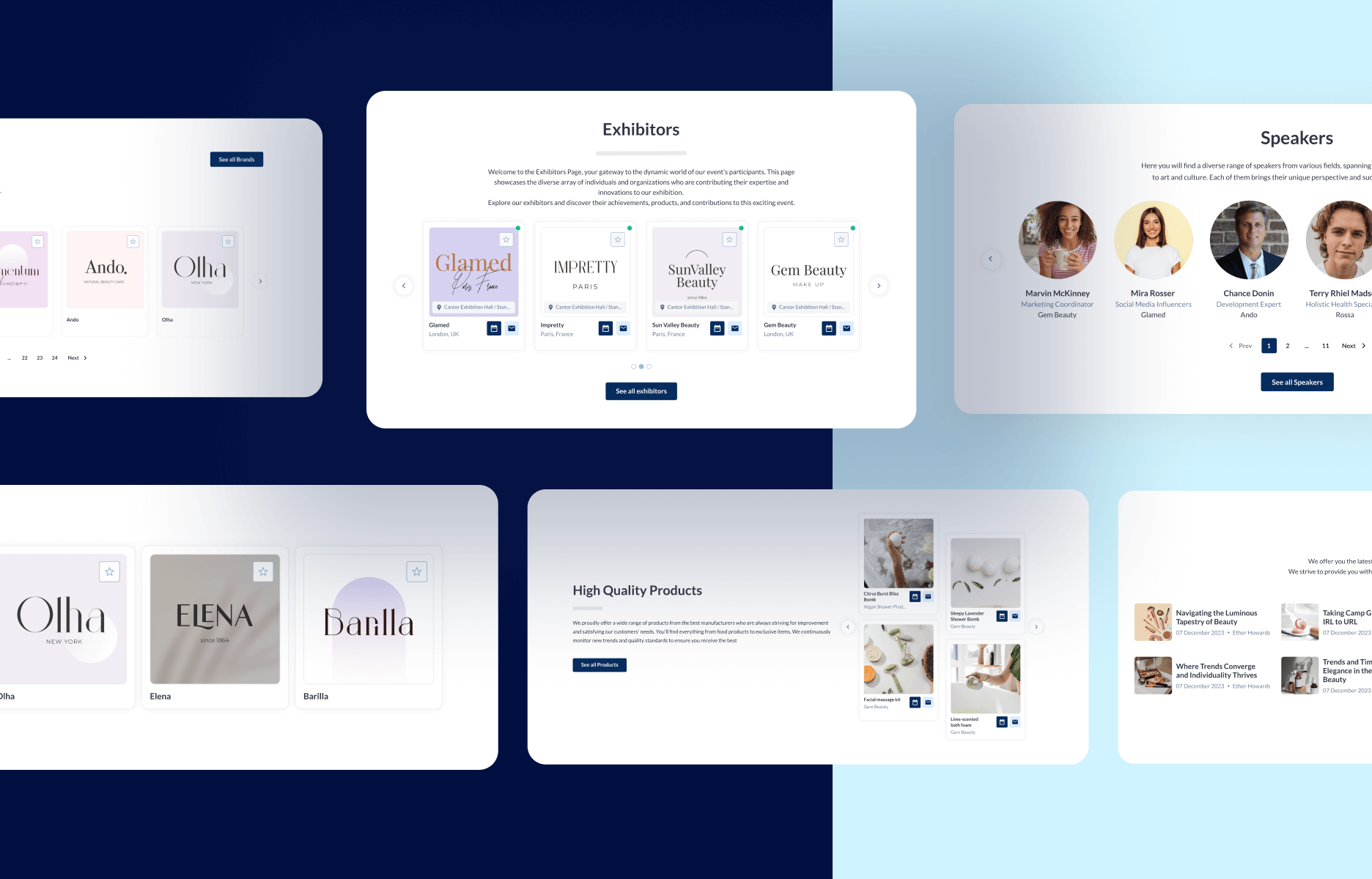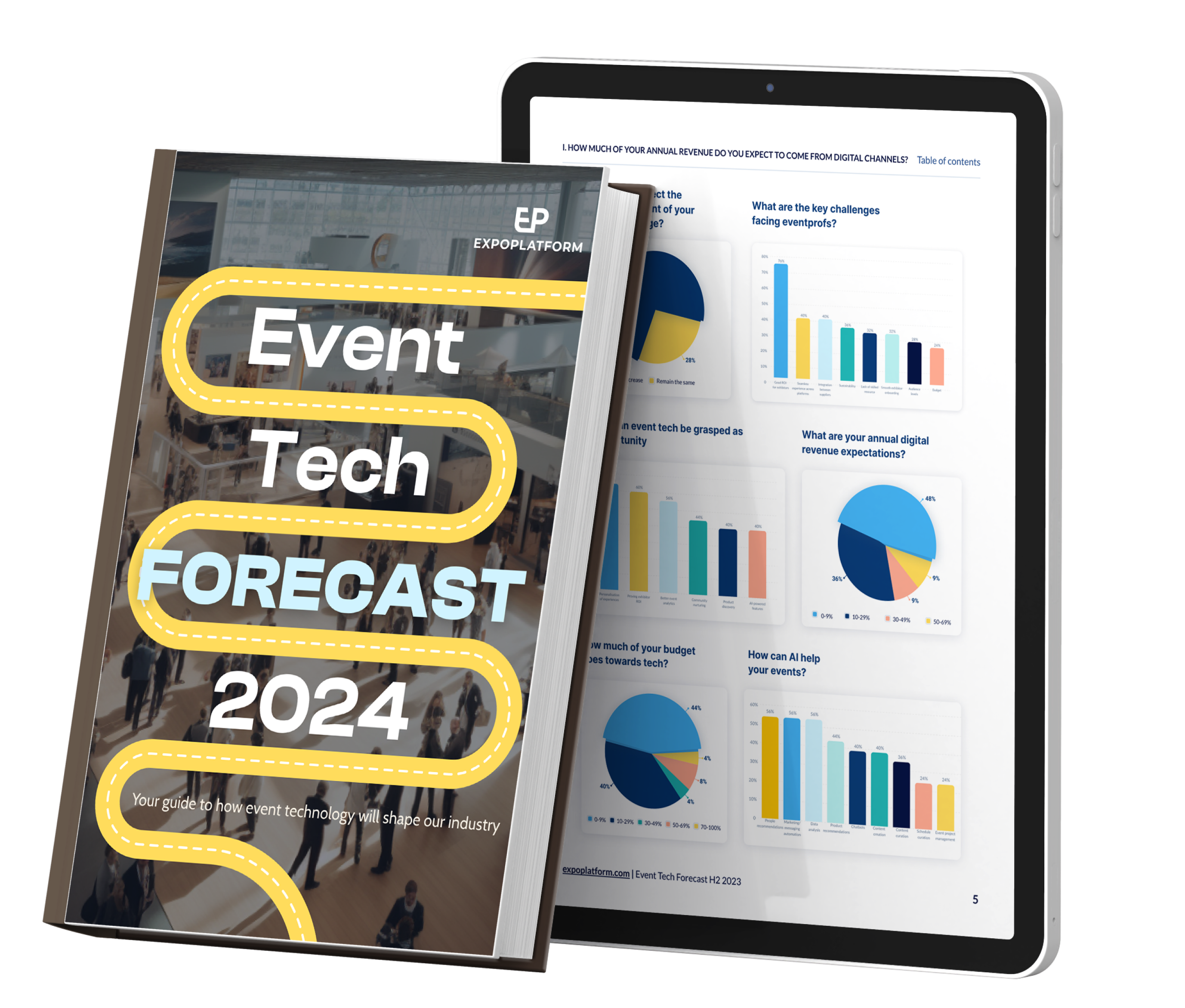
10 ways an event website fosters tradeshow success
Event websites have evolved from digital brochures to all-access information hubs. A feature-rich website now helps tradeshows facilitate buyer-seller connections and close business deals.
In this article, you’ll learn the 10 ways a dedicated event website can help tradeshows succeed ⤵️
📩 Download our Events Amplified ebook to learn how tools like event website and more can help amplify your event marketing.
1. Improve pre-event and post-event buzz 🔔
An event website acts as a digital headquarters for your tradeshow.
You can build anticipation and engage participants weeks and even months before the show goes live.
This is done by publishing relevant content, sneak peeks and interviews to create hype and anticipation.
It also means the event’s impact doesn’t have to fade once it concludes.
The website boost post-event engagement through content sharing, surveys and follow-up information.
This secures a lasting connection with attendees and paves the way for future participation.
2. Centralised information access 📑
An attendee’s experience is simplified by consolidating all essential event schedules, speaker bios, exhibitor information and venue maps onto a single platform.
A well-designed website provides them with quick access to important details – including the date, time, location and schedule of activities.
Easy accessibility reduces attendee confusion and frustration, improves their satisfaction and encourages more informed participation.
3. Seamless registration and ticketing 🎫
An intuitive event website provides a user-friendly registration and ticketing process.
Attendees can secure their spots hassle-free, while organisers can manage numbers efficiently through a streamlined process.
This reduces the burden on staff and helps in smoother event execution by tracking attendance and revenue.
You can also offer real-time updates on ticket availability and pricing as well as offer discounts and promotions to encourage early registration.
4. Allows attendees to research your show beforehand 🔍
Attendees find it easy to scope out the event before it goes live using the website. Here’s how:
- Pre-plan: Attendees can scan the list of participants and exhibitors – this helps them decide whom to meet in advance and draft tailored messages to boost interaction efficiency.
- Agenda setting: Identify the keynote speakers, workshops or parallel sessions happening – helps pre-decide what aligns with their interests and plan the schedule accordingly.
- Be technologically prepared: Is there an event mobile app or QR code scanning? Get familiarised with the tech tools in the tradeshow to ensure a smooth experience.
- Online preparation: Get access to valuable resources available on the website like blog posts, videos and tutorials to learn more about the show.
5. Dynamic content showcasing ⭐
An event website serves as a digital showroom for exhibitors and sponsors. Rich media content, such as videos, product galleries and interactive displays can showcase what participants can expect on-site.
Videos provide opportunities for live product demonstrations, virtual tours of showrooms and expert interviews that deepen engagement.
High-quality images and galleries allow exhibitors to present their offerings from multiple angles, showcasing intricate details that might be missed in person.
Interactive displays such as 3D models or virtual reality experiences elevate engagement levels and enable attendees to explore products or environments with new depth.
This dynamic content showcasing allows exhibitors to convey their brand’s essence, demonstrate product functionality and highlight unique selling points.
6. Help attendees connect 🔗
Attendees can connect with exhibitors, speakers and other participants using a website with networking features like AI matchmaking, meetings and messaging.
Organisers can plan targeted networking by enabling filtered searches, virtual interactions and inbuilt messaging.
This helps attendees connect with like-minded individuals and explore potential business opportunities within their niche.
The website’s advanced search capabilities ensure that participants can efficiently find the right contacts to expand their professional network.
7. Boost global reach, accessibility and visibility 🌐
Your tradeshow transcends geographical boundaries and becomes accessible to a global audience. The website extends its reach beyond traditional limitations and bolsters it on the international stage.
- An event website establishes an online presence, making it easier for both attendees and sponsors to find information about your show.
- It can serve as a platform for promotional updates and activities such as giveaways.
- Using sophisticated analytics, your website can track visitor engagement and deliver valuable data on event ROI.
8. Help organisers streamline planning 🌊
For organisers, an event website makes planning a breeze. It is equipped with various integrations such as:
- Exhibitor manual to help onboard exhibitors quickly to the tradeshow.
- Hosted buyer solutions to set table meetings between pre-qualified buyers and exhibitors.
- Interactive 3D floor plan to help attendees navigate through the venue without hassle.
- Facilitate lead generation with messaging and networking functionalities, helping spark conversations and drive conversions.
9. Increase event sponsorships 💷
Event sponsorship isn’t just about the event itself, it’s about harnessing multichannel opportunities for brand exposure – and your event website is a key player in that mix.
Let’s understand the options websites offer to increase sponsorship at your show:
- Branding opportunities such as exhibitor profile header and background image, digital meeting rooms and sessions.
- Real-time statistics dashboard for premium exhibitors to track impressions and clicks of pop-up, search and video statistics.
- Wider presence for exhibitors by enabling specialised content for their category along with a premium showroom profile.
- Search results priority for premium exhibitors and products.
- Ability to set networking limits and permissions for different exhibitor categories – helps organisers create packages with ease.
10. Collect valuable attendee data 📊
Event website analytics help organisers gain critical insights into attendee preferences and behaviours.
This data empowers strategic decisions and helps tailor future events to better meet the needs of the target audience.
With the right tools and features, an event website can help you gather meaningful data about your attendees – including their contact information, job titles, interests as well as onsite behaviour and preferences.
This data can then be used to create targeted marketing campaigns and tailor your content and activities to specific audience segments.
You can gain insights into what works and what doesn’t and make data-driven decisions to optimise your trade show for maximum impact and ROI.
Get started with your event website today with zero coding experience – learn more about our event website builder
We hope you enjoyed reading this article and found it useful. At ExpoPlatform, we want to help you build better events and communities. Please get in touch and ask for a demo here. Thank you 😀
There's more you might like

How to build a high-impact tradeshow website in 2024
Tradeshow websites serve multiple purposes. They are a bridge between buyers and exhibitors, a showcase to highlight products and brands and a comprehensive resource for event-related information. In this article, we do a deep dive on how to create a high-impact tradeshow website to get more clicks and conversions for your shows in 2024. Read ...


